Ejemplo de glosas en LaTeX
Algunas consideraciones sobre los ejemplos
Los siguientes ejemplos de glosas fueron extraídos del libro de Conti (2020). Los paquetes que se utilizaron fueron philex para la numeración y tipa para las glosas.
\lb{vaskia}{Vaskia (lengua madana; Ross, 1978, pág. 31), \textit{apud} \citep[pág. 151]{conti_fundamentos}\\
\textit{Gagi bamban \textbf{kaiyam-ale} Kaimkadi \textbf{tuam}}\\
Gagi pescado cocinó-MS Kaimkadi le.dar.3SG\\
`Gagi cocinó pescado (y) se lo dio a Kaimkadi'}

\lb{tipomarcadores}{
\lba{tipo1}{Marcador de enlace prepositivo:\\
\textit{\underline{Si} vienes mañana, te traigo el libro.} }
\lbb{tipo2}{Marcador de enlace pospositivo (kombay, lengua aviu-dumut: \textit{apud} Dryer (2013):\\
\textit{khe-khino rerakharu \underline{rodofe}}\\
POS-piernas hinchado porque\\
`Porque sus piernas están hinchadas'}
\lbz{tipo3}{Marcador de enlace inserto (encore-kiga, lengua bantú, \textit{apud} Dryer (2013):\\
\textit{wa-kanu \underline{obu} y-aa-tuuriza enjojo\\
señor-conejo cuando él-PAS-desafiar elefante\\
`Cuando el señor conejo desafió al elefante'}}}
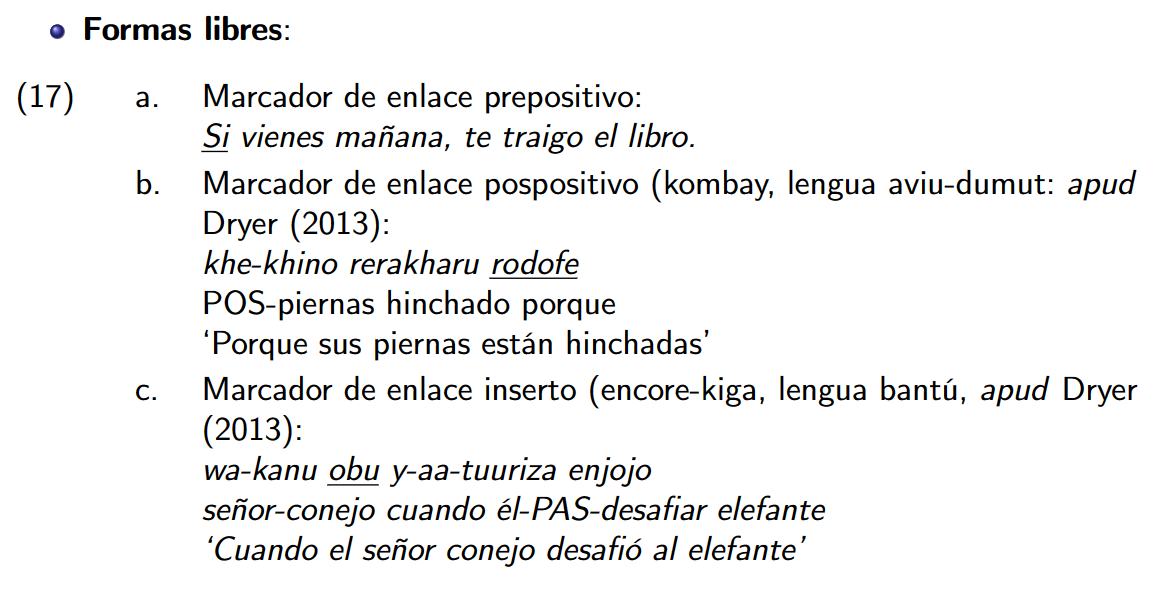
\lb{fconcatenadas}{
\lba{cform1}{Enclítico (yukulta, lengua tángica; \textit{apud} Dryer (2013))\\
\textit{\textipa{pulawa\|[ta-\ng i\ng ki, \hspace{0.3cm} [\ng apay=\underline{aka}=\ng ka \hspace{0.8cm} kalka]}} \\
morir.IND-él.FUT muy=porque=PRES enfermo\\ `Quizá muera, porque está muy enfermo'}
\lbb{cform2}{Morfema verbal (walpiri, lengua pama-ñunga; Lehmann (1986))\\
\textit{ \textipa{[njuntulu-lu \underline{kutja}-$\emptyset$-npa \hspace{0.3cm} wawiri pantu-mu,] \hspace{0.5cm}\ng ula kapi-na pura-ni \ng atjulu-lu }} \\ tú-ERG MENL-AUX-SUJ.2 canguro arponear-PAS DEM FUT-SUJ.1 cocinar-PRES yo-ERG \\ `Cocinaré el canguro que arponeaste'}
}
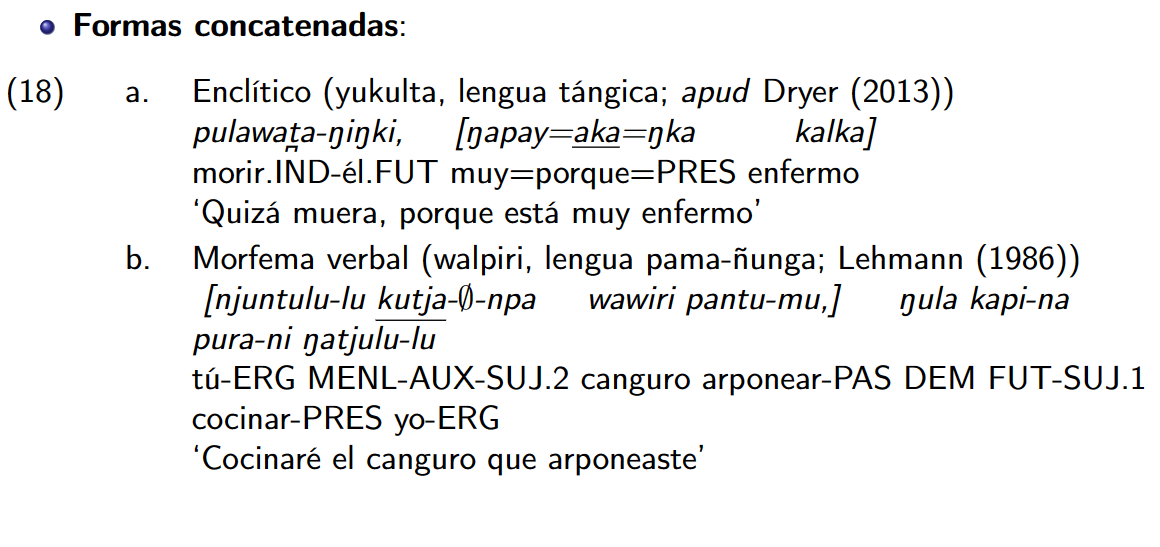
\lb{marcadcorrela}{
\lba{marc1}{\textit{Es \underline{tan} alto \underline{como} su padre. Comparativa } }
\lbb{marc2}{\textit{Apretó \underline{tanto} la tapa, \underline{que} el boté acabó rompiéndose.\\ Consecutiva } }
\lbb{marc3}{\textit{\underline{Si} no sabe montar en bici, \underline{entonces} tendrá que caminar.\\ Condicional } }
\lbb{marc4}{Hindi (lengua índica; Lipták (2009)) \\
\textit{ \textipa{[\underline{jo}} vahaaN khaRii hai\textipa{]} raam \underline{us} laRii-ko jaantaa hai }\\
REL allí parando es Ram DEM chica-AC conocer es\\ `Ram conoce a la chica que está allí parada' }
\lbz{marc5}{Chino mandarín (lengua sínica; Bisang (1998)) \\
\textit{J\textipa{\={\i}nti\=an \underline{su\={\i}-rán} yu\u{o}-f\={e}ng, \underline{d\`anshi} b\`u l\v{e}ng }}\\
hoy aunque ser-viento pero NEG frío \\ `Aunque hoy hace viento, no hace frío' }}
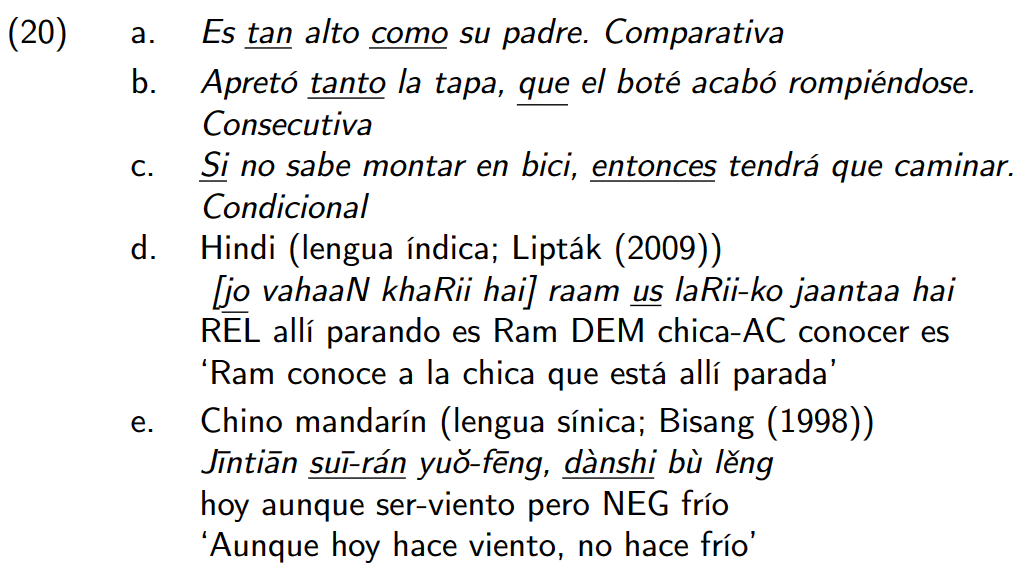
\lb{conveb}{
\lba{converb1}{Wixárika (lengua corachol; Comrie (1982))\\
\textit{\textipa{nee ne-nua-\textbf{ka} paapaa ne-p-ii-\textglotstop\textbari\textbari t\textbari}\\ yo 1SG-llegar-MS tortilla 1SG-3SG-dar}\\ `Cuando llegué, le di la tortilla' }
\lbb{converb2}{\textit{\textipa{nee ne-nua-\textbf{ku}, iya paapaa nec-u\textglotstop\textbari it\textbari }\\ yo 1SG-llegar-SD él tortilla 1SG-dar} \\ `Cuando llegué, me dio una tortilla' }}
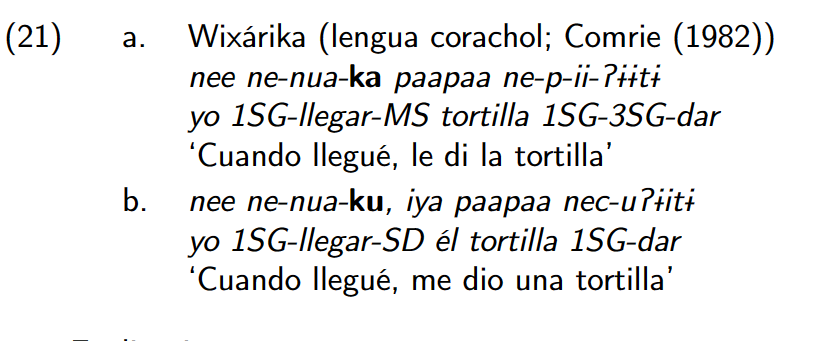
\lb{ejempaguaruna}{
\lba{agua1}{Aguaruna (lengua jíbara, Overall (2009)\\
\textit{\textipa{[yu-wa-tasa-\textbf{nu}] \hspace{1.5cm} wa\textbari\textturnmrleg-hai-i}} \\
comer.PERF-INIT-MS1SG querer.IMPERF-1SG-DECL\\ Lit. `Quiero que yo coma', `quiero comer' }
\lbb{agua2}{\textit{\textipa{[yawa\~a \textbari k\textbari na-\textbf{ma\~{\i}}] \hspace{2cm}maa-ha-i}} \\
perro levantar.PERF-SEC.SD1/3 matar.PERF-1SG-DECL\\ `Cuando el perro levantó (el agutí), (lo) maté' }
\lbz{agua3}{\textit{\textipa{[wak\textbari\textturnmrleg a-ku-m\textbari-\textbf{ka}] \hspace{2cm} yuwa-ta} }\\
querer.IMPF-SIMUL-MS2-COND comer.PERF-IMP\\ `¡Come si quieres!' }
}
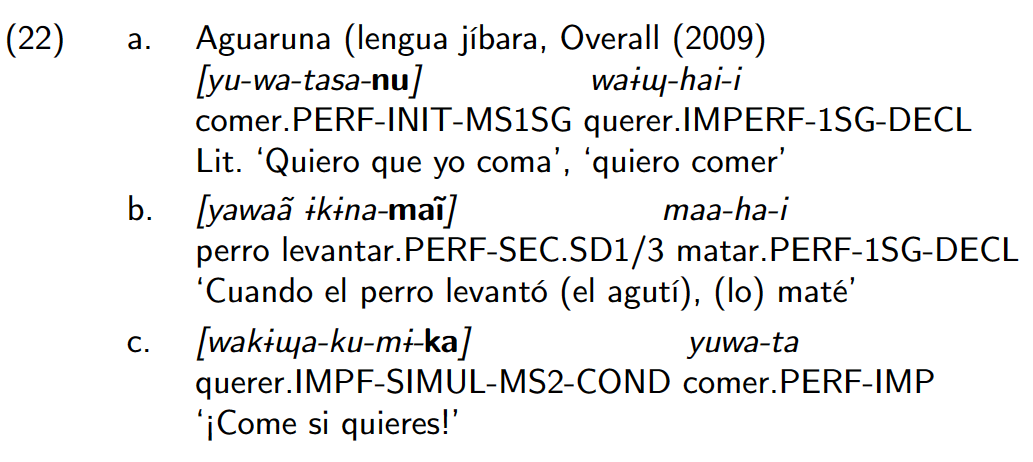
\lb{wappo}{
\lba{wappo1}{Wappo (lengua yuki, Thompson, Longacre y Hwang (2007)\\
\textit{\textipa{ah te \v{s}awo \textbf{pa\textglotstop -tah} ha is-khi\textglotstop}} \\
yo él.AC pan comer-PAS saber-NFUT\\ `Sé que comió el pan'}
\lbb{wappo2}{\textit{\textipa{cephi \v{s}awo \textbf{pa\textglotstop-ta\textglotstop}}} \\ él pan comer-PAS \\ `Comió pan'}}

\lb{kham}{
Kham (lengua kham-magar Watters (2009))\\
\textit{\textipa{\textbf{ba-o} op\textschwa\~{\i}-zya-o-t\textschwa, \textbf{ba-o} mao-d\textschwa i-wo}} \\
ir-NOMZ 3SG-querer-CONT-NOMZ-SUPERES ir-NOMZ\\ `Aunque quería ir, no se le permitiría (ir)' }

\lb{japonés}{Japonés (lengua japonesa, Comrie (1998))\\
\textit{\textipa{[}G\textipa{akusei ga katta] hon}} \\ estudiante NOM compró libro \\
`El libro que compró el estudiante'}

\lb{chino}{
\lba{chino1}{Chino mandarín (lengua sínica, Haspelmath (2013)\\
\textit{L\textipa{isi xiwang} Z\textipa{hangsan zao dian huijia}}\\ 'Lisi quiere que Zhangsan regrese pronto'}
\lbb{chino2}{\textit{N\textipa{\u{\i} gu\`\i-xi\`a-lái qiú} Zh\={a}ngs\={a}n }} \\
tú rodilla-bajar-venir implorar Zhangsan\\
1. `Te arrodillaste e imploraste a Zhangsan'\\
2. `Te arrodillaste para implorar a Zhangsan'\\
3. `Te arrodillaste implorante a Zhangsan'}
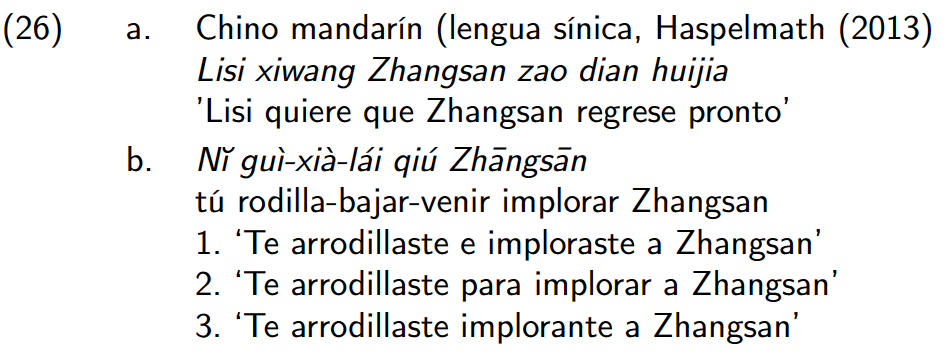
Referencia en formato Bibtex
@book{conti_fundamentos,
title={Fundamentos de sintaxis tipol{\'o}gica},
author={Conti, Carmen},
year={2016},
publisher={Editorial S{\'\i}ntesis}
}
Referencia en APA
Conti, C. (2016). Fundamentos de sintaxis tipológica. Editorial Síntesis.
Written on December 21, 2023